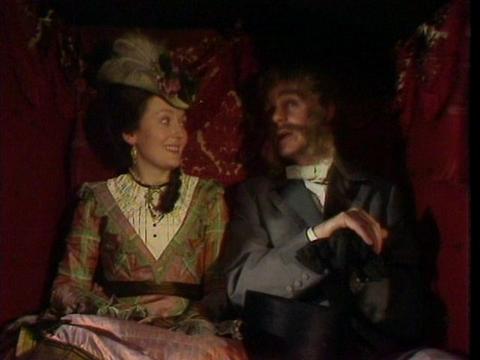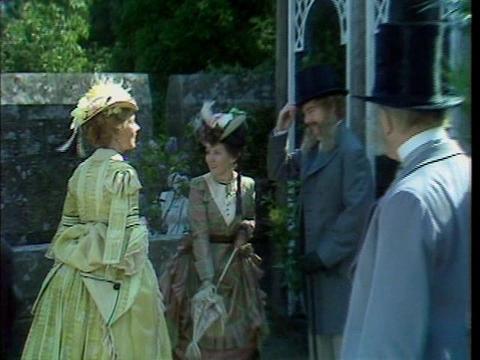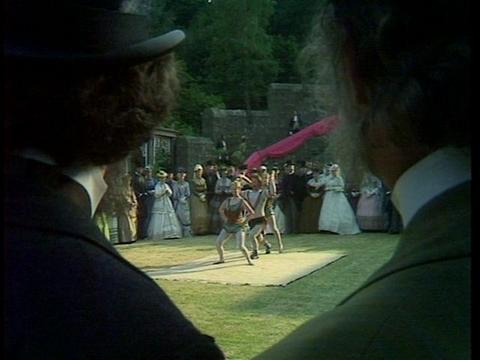Ellen and Jim Have a Blog, Too
We are two part-time academics. Ellen teaches in the English department and Jim in the IT program at George Mason University.


Pallisers 6:11: the Lizzie Eustace & Lord Fawn matter begins · 5 May 08
Gentle readers,
Often as I begin to watch one of these quality mini-series slowly, I discover what I hitherto didn’t like at all begins to appeal to me; by going slow I overcome some of my adverse reactions to popular archetypes by seeing the careful nuances and intelligence of the performance that qualifies the nonsense, how mise-en-scene develops the narrative, hear good dialogue, and soon am entering into the experience fully enough.
I had remarked how in the scene in Pallisers 5:10 where we are introduced (with fanfare and point) to Fawn, I was impressed by the dignity of his performance, the tact with which Jacobi allowed himself to become a clown of bigoted stupidity without becoming quite the ass that the part could have played into. He does not ham it up (as I have seen for example Edward Petherbridge on stage hamming up 18th century fops as men-in-drag).
Our postings this week on Trollope-l about the first eight chapters of Trollope’s Eustace Diamonds reminded me again what a problem Raven had with this material in this novel. A hateful heroine is not a formula for winning viewers; Trollope’s scathing presentations of Lizzie Eustace’s strengths, sexuality, and manipulative would not appeal to a majority middle to higher status female audience (which generalization about the proportion of women in TV audiences may not be exactly true in the case of mens’ high status novels, but is true enough to worry a screenplay writer).
So he underplays the character traits from Trollope, & in the first two scenes we see her she is reduced to a semi-clown in this opening scene, someone frustrated by Fawn’s conventionality: he wouldn’t taker her superior coach but nonetheless is not “man” enough to make the coachman drive fast. The jokes here are consonant with the Duke becoming a feeble aging old man under the control of Lady Glen and Madame Max, the new Lizzie and Fawn matter is going to show us emasculated men as a semi-joke.
The first shot we get of Lizzie Eustace (played by Sarah Badel) in the Pallisers series occurs in 6:11, Episode 15, “The Escape:” Lizzie (as she’s called) is seen sitting in a close carriage with Frederick Viscount Fawn (Derek Jacobi). She overtly manifests patient impatience as he has not managed to get them to the Duke’s lawn party (at Horns in the novel) in time for the acrobats. Of course she would want to see the acrobats.

First shot of Lizzie Eustace (Sarah Badel) and Lord Fawn (Derek Jacobi) hurrying to the Duke’s party; they may be too late for the acrobats (Pallisers) (BBC 1974)
Here is a transcript of this scene:.
We see a black carriage driving up. Then a mastershot of the whole carriage. Cut to the inside. Two people slammed in not enough room.
Lizzie: If we don’t get there soon, we shall have missed the acrobats.
Fawn: What can I do?
Lizzie: Well, you might tell him to drive faster, dearest. [she
pronounces dearest with slight irony]
Fawn: He is going as fast as he can [carriage lurches, we hear a hard sound] We’ve already had one accident.
Lizzie: Since your sense of what is proper denied us the pleasure of driving in my carriage, you mght at least have hired one without a wobbly wheel.
Fawn. You talk as if I did it on purpose.
Lizzie: Well, at this rate, we’ll have died of old age before we get there.
Fawn bangs on roof with cane.
Lizzie: A hearse would have been quicker.
Cut back to gardens …
In brief and to conclude, there is a genuine comedy in first two scenes of Fawn and Lady Eustace. This second occurs as the lecherous aging Duke comes upon them on his way to the acrobats.

Sunlit moment of high youth: Lizzie Eustace (Sarah Badel) and Lord Fawn (Derek Jacobi) met by Lady Glencora (Susan Hampshire) as seen by the Duke of Omnium’s (Roland Culver)
On our emerging principals: Sarah Badel reads effectively for unabridged texts for cover-to-cover—showing she understands them. Jacobi reads brilliantly modern translations of Virgil’s Aeneid and Homer’s Iliad, so he’s no mean intellect himself. Badel is particularly good at hard novels like Austen’s S&S, which is often sardonic and dry, and also at hard comedy. Instead of Trollope’s snake-like slithering sexy heroine, when she is presented to the Duke, Badel contrives to be a sort of coquettish ingenu, sweet in appearance if not to be trusted. She’s apparently small too, shorter than Susan Hampshire & Barbara Murray. Jacobi leans over her.
In 6:11, Raven’s use of acrobats is inspired for we feel we are watching life moving on in its silly, amused and tragic phases. All the people we have known gather for this nonsense; it’s how people pass time. Each one in his or her own way. The acrobats work hard too. We have been with these characters for so long; Duke’s glass of champagne (ordered just as they begin) is a repeat of his action the first time we see him in 1:1. Madame Max’s (Barbara Murray) sad face alongside the Duke is a tiny bit of the scene; she’s just been rejected by Phineas who will soon depart this scene for Ireland to marry Mary Flood whom he’s impregnated. The characters we don’t know are dressed to the nines & yet are anything but heroic in type and gesture, they aging, crumpled, unglamorous. All sitting or standing there as a tracking shot catches Lady Laura (Anna Massey) darting past the crowd to the stairs as Kennedy (Derek Godrey, now crazed but still played with at least a bit of sympathy) peers out to find her intensely and anxiously.

Through shoulders of Dolly Longestaffe (Donald Pickering) and Barrington Erle (Moray Watson), choral figures, we glimpse Lady Laura (Anna Massey) fleeing her husband
Hero and heroines, Phineas, Laura, Madame Max, flee or take a back seat (Madame Max is now tame best friend to Lady Glen and nurse to the Duke), Lady Glen and Plantagenet Palliser turn into choral figures to make way for our comic pair who will not be burdened in the way of the two previous novels. Phineas and Laura will vanish and the Palliser set will be contextualized by a doddering salacious drone of a Duke. We are into caricature as Raven’s way of coping with this novel where we do (against Trollope’s grain somewhat) proto-feminist females and Trollope’s intense hatred of his Becky-Sharp type heroine.
Trollope’s Eustace Diamonds it’s worth saying is not focused on Fawn but rather Frank Greystock who I suppose Raven had little sympathy for—he’s a John Grey without the integrity or real compassion of heart (not that Raven cares about these things so much). With the new mood of mini-series (and more women writers) I suspect Trollope’s good women, Lucy Morris, the vulnerable governess, and Lady Fawn, her kind if dense employer, would not have been dropped but presented as Austen-like heroines. But more of all this anon.
Ellen
--
Posted by: Ellen
* * *
Comment
- I wrote this in response to Nick on “Hating the heroine.” Much of it is a summary and commentary on his posting (which I have not been able to get onto the comments; I've struggled but have not managed it):
Nick made several large points and illustrated them through Trollope’s failure (I’ll put it) to keep up hating the heroine, and his strong tendency in these and other chapters of the book to present a mixed view of her (and all his characters), sufficiently sympathetic that we can see framed by his hatred a woman who we could sympathize with, and whose faults or flaws are not just understandable but survival techniques in a hard mean world. Lizzie is not the only heroine whose survival techniques earn Trollope’s ceaseless condemnation all the while he shows she had no other choice but to become a victim: the inference is she should have become that victim. These heroines include Lady Carbury and Mrs Hurtle in The Way We Live Now: Lady Carbury should have starved and not retaliated and deserted after the beatings of her husband; Mrs Hurtle should not have tried to shoot and kill him for ravaging, beating, exploiting her.
As Nick said, Trollope not only presents circumstances, but later on enters into Lizzie’s mind and empathizes. I see this particularly after the diamonds are not stolen but appear to be. She would love to get rid of them, but they have become a sort of vampire on her, an obsession she can’t rid herself of; at the same time she could throw them down a sink, but they are worth money and all along she has had in her mind the money she could get for them. Keeping friends for a woman outside the norms like her costs money: she has to support the Carbuncle-Lord George group, and would probably have to do that with others.
Nick then went on to detail what are the traits that make Lizzie a bad woman: she does well for herself, she’s a good bargainer, traps men, likes jewels, is a liar and superficially clever (good atmanipulating people up a point). What is this but what Frank Greystock would do? He doesn’t need to trap a woman, but he’d marry for money.
They are all traits that make for a strong woman who a man would not find dependent on him and not be submissive; she could go outside his demands for obedience with no trouble. Interestingly Lizzie is not the sort of woman who resorts to a use of sex outside marriage for money; she’s too hard for that; here is her parallel with Griselda Grantley, the frigid princess of Barsetshire.
As Nick also said, Trollope also doesn’t allow Lizzie to be really smart; she ends up with mean stupid men and makes very stupid decisions; her amorality is presented as moral stupidity which leads her to make unethical choices which naturally (poetic justice here) lead to unhappiness.
Lizzie’s a snake like lithe woman, making me remember Spenser and Milton’s allegories for sinful mermaids (with sex all beneath their hideous waists).
**************
All this said I detest Lizzie Eustace but on quite other grounds, and probably these are similar to why I dislike Griselda Grantley. First I’m a woman and not at all attracted to either (as I’m told it’s natural for Frank to be in the book); not just this but temperamentally I find the archetype of the femme fatale as presented in 19th century literature (say Wilkie Collins) absurd or if versions in real life can be found something I’d never ever want to be. I cannot take the performativeness of Lizzie, her arrogance, her coldness, her lack of heart. I don’t want the jewels either— I’ll write separately about them as they are important. I don’t respect her ambitions; I do think them detritus. Who wants the
admiration of the dolts of the world; but then I don’t understand why Mrs Clinton wants to be president so bad she’d do and say just about anything to get it.
I’m consistent here for I equally dislike Frank Greystock. I meant to write about how I prefer Trollope's Chiltern to him, and will do so briefly here. Greystock is a pragmatic bully; he’s a hypocritical bully; he’s willing to bully Fawn on an issue he cares nothing for but to make points for his party. Chiltern was faithful to Violet, and was constant, and saw politics for a corrupt game. Violet as he was it was not a calculated move for gaining advancement. Yuk. What Lucy sees in this man I cannot see. What he sees in Lizzie Eustace as described by Trollope ditto. And Trollope justifies him. We are to despise Mrs Carbuncle but apparently Lord George has integrity enough for Trollope. Oh dear. The man who this semi-prostitute supports; I don’t see him saving Lucinda from the horror they want to give her too (a hawk is the allegorical name).
In disliking both of them that does not mean I dislike the book. I don’t think a heroine or hero need be an exemplary character at all: this is a book which critiques the social and familial worlds as sharply as The Way We Live Now and perhaps with much more nuance and detail.
Now that detail and nuance as I see it come from the book being conceived as part of the series. Trollope intended all along tobring in the Pallisers and Madame Max as chorus, and the richness of the textual world that is the Parliamentary novels is here.
My dislike of the heroine on different grounds from those Trollope erects does mean that what he thinks funny I don’t. I don’t find Lord Fawn funny and don’t laugh at the jokes at his expense. I really do identify with those who are vulnerable and sensitive, even stupid vulnerable sensitive people. I see a strong macho male point of view which would have me laugh at Fawn (even his name) and I don’t go for it.
I’m with Marye in saying the heroine of the book that is at its core meaning is Lucinda Roanoke, but I also like Lucy Morris.
Yes I like her as I do very much Alice Vavasour, Lily Dale—she is strong and will not kowtow; she has integrity of heart. I loved whenshe refused Lizzie’s bribe. I’m like that judge who told Mia Farrow that he liked all her decisions and what she did given her circumstances except when she involved herself with that creep Woody Allen. I feel for her and empathize. The problem is what she fights for is this creep. I could see John Grey (I think I have said that) as a life partner, also Plantagenet Palliser, for off hours Burgo. I could go on how Trollope never gives his heroines other options than marriage but that is the old problem of his severe limitations when it comes to women. But then it does lead him to show the world’s views and we can see in Lucy what happens to vulnerable women. Were it not for this creep doing the right thing (partly becuase he’s afraid of Lizzie), she would have to live her life with the dull Lady Fawn whose kindness is only matched by her stupidity. So I feel for her when she stands up to another monster woman of Trollope’s, another elderly harridan with a poisonous withering tongue.
Really I’m sometimes surprized Trollope’s heroines don’t all have nervous breakdowns and try to commit suicide. Only a few do, and only a couple succeed (when they are about to be sold to a man they detest by a harridan woman relative). Alice is a depressive and some of the heroine justifiably are. But then this is true to life too and I like the books for the many complicated portraits of male and female depressives who mirror Trollope’s inner life.
Ellen
— Elinor May 8, 2:28pm #
commenting closed for this article
